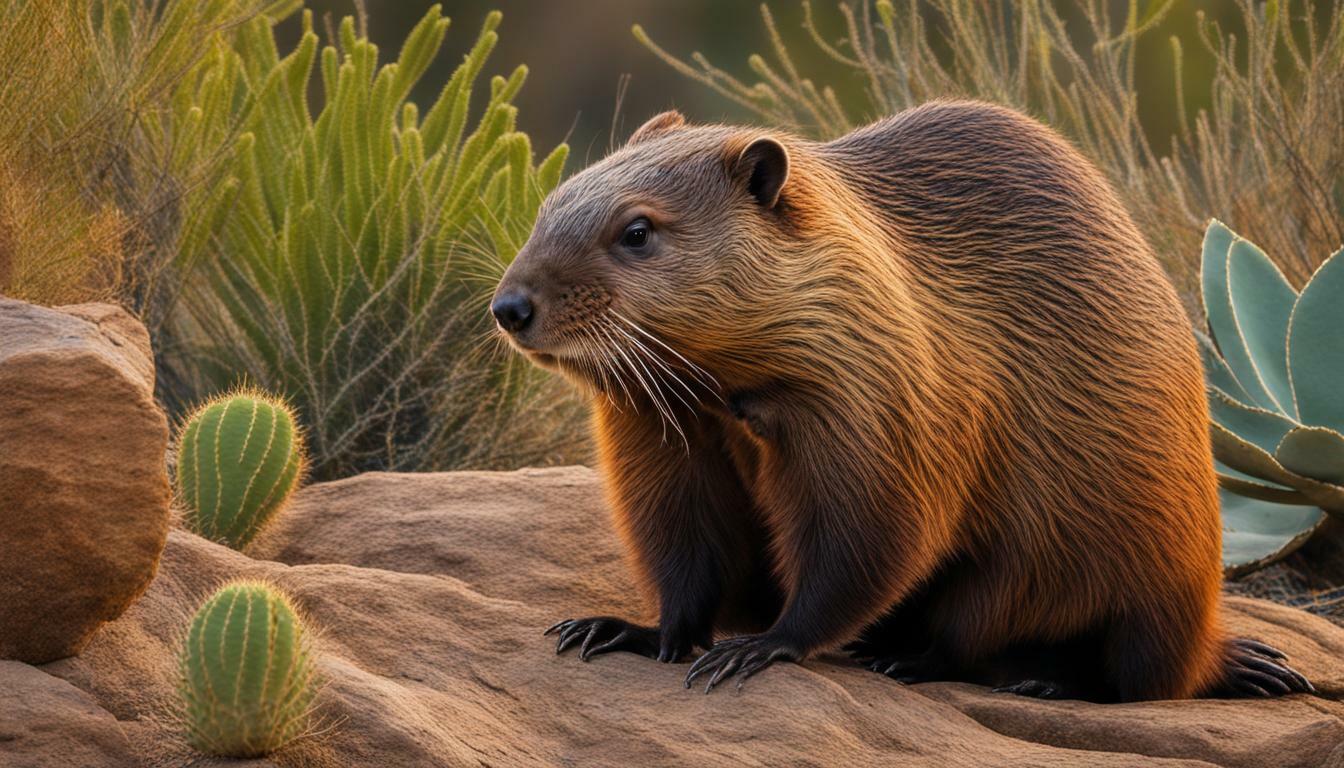If you’ve ever wondered whether beavers live in Texas, you’re in for a treat! These industrious creatures, known for their ability to shape the landscape with their dams, do indeed call Texas home. While they were once wiped out from the area thousands of years ago, beavers have recently begun to recolonize the state.
Key Takeaways:
- Beavers do live in Texas, recolonizing the state after being wiped out thousands of years ago.
- They are abundant in wetter, eastern parts of the state and have been spotted as far west as El Paso.
- Beavers create wetlands and their activities benefit the ecosystem and support other wildlife.
- They primarily feed on vegetation, including the cambium layer of trees.
- Controlling beaver populations can be done through exclusion, trapping, shooting, or chemical methods.
Beaver Species and Habitats in Texas
Texas is home to two species of beavers – the North American beaver (Castor canadensis) and the more rare Mexican beaver (Castor mexicanus). These fascinating creatures have made a remarkable comeback in the state after being wiped out thousands of years ago. Today, they can be found in various habitats throughout Texas, particularly in wetter, eastern regions of the state.
North American beavers, known for their characteristic flat tails and impressive dam-building skills, are the most common species in Texas. They create elaborate lodges with underwater entrances and use dams to create their own wetland habitats. Mexican beavers, on the other hand, have a more limited distribution and are primarily found in the Rio Grande watershed near Big Bend National Park.
The habitats that beavers thrive in include rivers, streams, ponds, lakes, and wetlands. They prefer areas with ample vegetation for food and construction materials, such as willows, cottonwoods, and other woody plants. Beavers play a crucial role in shaping these ecosystems by altering water flow, creating new habitats, and providing food sources for other wildlife.
| Beaver Species | Habitat |
|---|---|
| North American beaver | Rivers, streams, ponds, lakes, wetlands |
| Mexican beaver | Rio Grande watershed near Big Bend National Park |
Table: Beaver Species and their Habitats in Texas
Distribution of Beavers in Texas
While beavers were once wiped out from Texas, they have been making a comeback in recent years and can now be found in various regions of the state. These industrious creatures have recolonized parts of Texas and are most abundant in the wetter, eastern areas. However, they have also been spotted as far west as El Paso, expanding their range in the state.
Beavers are known for their ability to create wetlands, and their presence in Texas is no exception. They build dams and lodges along rivers and streams, transforming the landscape and providing habitat for numerous other wildlife species. If you’re wondering where to find beavers in Texas, look for their unmistakable signs, such as chewed trees, large lodges, and the presence of standing water caused by their dam-building activities.
These remarkable creatures primarily feed on vegetation, including the cambium layer of trees. They are adept at felling trees using their sharp incisors and strong jaws. Beavers are known to mate for life and live in family colonies, which typically include the adult breeding pair and their kits. The young are born in May or June, adding to the growing beaver populations in Texas.
| Region | Beaver Population |
|---|---|
| Eastern Texas | Abundant |
| Central Texas | Increasing |
| Western Texas | Expanding (including El Paso) |
Management and Landowner Options
Controlling beaver populations can be challenging, as they are tenacious builders. However, it can be done through various methods, including exclusion, trapping, shooting, or the use of chemical deterrents. It is worth noting that while it is legal to trap beavers in Texas, restrictions apply to the sale of their pelts.
For landowners who wish to coexist with beavers, there are options available. Live trapping and relocation can be a humane and effective way to manage beavers on your property. Consult with local wildlife authorities or professionals for guidance on the proper procedures and regulations for trapping and relocating beavers in Texas.
In conclusion, beavers have returned to Texas after being wiped out from the area thousands of years ago. They can now be found in various regions of the state, primarily in the wetter, eastern parts. Their presence is beneficial to the ecosystem, creating wetlands and supporting other wildlife. If you encounter signs of beaver activity in Texas, appreciate these fascinating creatures and their remarkable ability to shape their environment.
Beaver Behavior and Activities in Texas
Beavers are fascinating creatures with unique behaviors, and their activities play a crucial role in shaping the landscape of Texas forests. These industrious rodents are known for their ability to construct elaborate dams and lodges, which serve as their homes. Their engineering prowess not only creates habitat for themselves but also impacts the surrounding environment.
Perhaps one of the most remarkable aspects of beaver behavior is their skill in manipulating water flow. By building dams across streams and rivers, they create ponds and wetlands that provide essential habitat for a variety of plant and animal species. These wetlands help filter water, regulate its flow, and recharge groundwater, making them vital to the overall health of ecosystems in Texas.
Beavers primarily feed on vegetation, including the cambium layer found just beneath the bark of trees. Their constant gnawing and felling of trees may initially seem destructive, but it actually promotes forest regeneration. By creating openings in the canopy, new vegetation can thrive, and the cycle of growth and renewal continues.
| Beaver Facts in Texas: |
|---|
| Beavers mate for life |
| They live in family colonies |
| Kits are born in May or June |
Controlling beaver populations can be a challenge. However, various methods are used to manage their numbers when necessary. These methods include exclusion techniques that prevent beavers from accessing certain areas, trapping, shooting, and the use of chemical deterrents. It is important to note that it is legal to trap beavers in Texas, but there are restrictions on the sale of their pelts.
For landowners who encounter beavers on their property, there are options available. Live trapping and relocation can be a humane way to manage conflicts, allowing beavers to inhabit suitable areas while minimizing damage to human structures. It is essential to consult local wildlife authorities and adhere to legal requirements when dealing with beavers in Texas.
The Role of Beavers in Texas Forests
Beavers play a vital role in shaping the landscape of Texas forests. Through their dam-building activities, they create a network of wetlands that provide habitat for numerous species. These wetlands act as natural filters, improve water quality, and help mitigate the effects of flooding by absorbing excess water. Furthermore, the tree felling and vegetation consumption carried out by beavers contribute to the dynamic nature of forest ecosystems, fostering new growth and supporting a diverse array of wildlife.
Importance of Beavers in Texas Ecosystems
Beavers are considered ecosystem engineers, as their dam-building activities create vital wetland habitats that benefit numerous species in Texas. These industrious animals construct dams using logs, branches, and mud, which result in the formation of ponds and wetlands. These wetland habitats serve as homes for various wildlife species, including birds, fish, reptiles, and amphibians. The interconnectedness of these habitats provides breeding and foraging grounds, protects against erosion, and improves water quality.
One of the primary benefits of beaver dams is their ability to regulate water flow. By creating barriers in streams and rivers, beavers slow down the movement of water, allowing it to spread over a larger area. This helps prevent flooding during heavy rains and ensures a consistent water supply during dry periods. The slowing and pooling of water also facilitate sediment deposition, which enriches the soil and promotes the growth of aquatic vegetation.
Table 1: Wildlife Supported by Beaver Wetland Habitats in Texas
| Species | Description |
|---|---|
| Wood ducks | Nesting in tree cavities along wetland edges |
| Turtles | Utilizing the wetland for basking and nesting |
| Fish | Using the wetland as a nursery and feeding area |
| Amphibians | Dependent on wetland for breeding and habitat |
| Wading birds | Foraging for food in the shallow waters |
In addition to creating wetland habitats, beavers also play a crucial role in maintaining healthy forest ecosystems. They primarily feed on vegetation, including the cambium layer of trees, which stimulates new growth and regeneration. This process helps to diversify the forest, promote the growth of other plant species, and provide habitat and food for a variety of wildlife. By altering their environment, beavers contribute to the overall resilience and biodiversity of Texas ecosystems.
It is important to recognize the value of beavers in Texas and to implement effective management strategies that balance their presence with the needs of landowners. Controlling beaver populations can be challenging, but methods such as exclusion, trapping, shooting, or chemical deterrents can be utilized. It is legal to trap beavers in Texas, but restrictions apply to the sale of their pelts. Landowners also have the option to live trap and relocate beavers if they wish to coexist with these beneficial creatures.
Beaver Management in Texas
Controlling beaver populations in Texas can be a challenge, but there are several methods available to manage their numbers and minimize potential conflicts. These methods include exclusion, trapping, shooting, and chemical methods. Each approach has its own advantages and considerations, and the choice of method may depend on the specific situation and goals of landowners.
Exclusion is a common method used to protect trees and prevent beavers from damming areas where flooding may occur. This involves installing fencing or wrapping trees with wire mesh to create a physical barrier that beavers cannot easily overcome. Exclusion methods can be effective, but they may require regular maintenance and monitoring to ensure their continued effectiveness.
Trapping is another technique used to control beaver populations. Traps are set near beaver activity, such as dams or lodges, to capture and remove individual beavers. It is important to note that trapping regulations and restrictions apply in Texas, and landowners must comply with these regulations when trapping beavers. Additionally, it is legal to trap beavers in Texas, but restrictions apply to the sale of their pelts.
Common Beaver Management Methods in Texas:
- Exclusion: Fencing and wire mesh to protect trees
- Trapping: Capturing and removing individual beavers
- Shooting: Culling to reduce population numbers
- Chemical methods: Using repellents or toxicants as a last resort
Shooting is sometimes used as a method of reducing beaver populations. This method requires a permit and must be done safely and responsibly. It is important to consult local regulations and authorities before considering shooting as a management option.
Chemical methods, such as repellents or toxicants, should be considered a last resort and used with caution. They should only be used by licensed professionals who have the expertise to apply them safely and in accordance with legal requirements. Care should be taken to minimize potential risks to non-target species and the environment.
| Management Method | Advantages | Considerations |
|---|---|---|
| Exclusion | Protects trees and prevents flooding | Requires regular maintenance and monitoring |
| Trapping | Allows for individual beaver removal | Must comply with trapping regulations |
| Shooting | Reduces population numbers | Requires a permit and must be done safely |
| Chemical methods | Last resort option | Should only be used by licensed professionals |
Landowners who wish to control beaver populations on their property should carefully consider their goals, the specific circumstances, and the potential impacts of each management method. It may be beneficial to consult with local wildlife management agencies or experts to determine the most appropriate approach for their situation.
Beavers and Landowners in Texas
If you are a landowner in Texas and encounter beaver-related issues, there are legal guidelines to follow and options available for handling these situations. Beavers can have a significant impact on properties, especially when they construct dams that may cause flooding or damage trees through their feeding activities. However, it is important to note that beavers are protected wildlife in Texas, and it is illegal to harm or kill them without proper permits from the Texas Parks and Wildlife Department (TPWD).
If you find beavers altering your property, the first step is to contact your local TPWD office for guidance. They can provide you with information on beaver management options and help you understand the legal requirements specific to your situation. In some cases, live trapping and relocation may be recommended as a humane way to address beaver-related issues.
Live Trapping and Relocation
Live trapping involves using specially designed traps to capture beavers without causing them harm. Once trapped, the beavers can be safely relocated to more suitable habitats, such as conservation areas or approved release sites. However, it is crucial to follow TPWD guidelines and obtain the necessary permits before undertaking any trapping or relocation activities. These guidelines help ensure the welfare of the beavers and prevent the spread of diseases.
| Steps for Live Trapping and Relocation |
|---|
| 1. Contact your local TPWD office to notify them about the beaver-related issues on your property. |
| 2. Follow TPWD guidelines and obtain the required permits for live trapping and relocation. |
| 3. Use approved live traps to capture the beavers, placing them near their activity areas. |
| 4. Check the traps regularly and release the trapped beavers in approved locations as directed by TPWD. |
| 5. Implement preventative measures to discourage beavers from returning to your property, such as installing fences or using tree protectors. |
By following the proper procedures and working closely with TPWD, landowners can effectively address beaver-related issues while also ensuring the protection and conservation of these valuable wildlife species in Texas.
Beavers in Texas: Fun Facts
Did you know that beavers mate for life and raise their young in family colonies known as lodges? These fascinating creatures have a unique way of living that sets them apart from other wildlife in Texas. Let’s dive into some fun facts about beavers in the Lone Star State.
Beaver Facts
1. Ecosystem Engineers: Beavers are considered ecosystem engineers due to their ability to create wetlands. They build dams using branches, mud, and rocks, which helps to regulate water flow, prevent erosion, and provide habitats for a variety of other species.
2. Tree Chompers: Beavers’ strong teeth are adapted for gnawing on trees. They primarily feed on vegetation, including the cambium layer of trees, which is the living tissue beneath the bark. This diet helps keep their teeth sharp and healthy.
3. Wider Range: Beavers were once wiped out from Texas but have recently made a comeback. They are abundant in wetter, eastern parts of the state and have even been spotted as far west as El Paso. Their expanding range is a testament to their adaptability.
4. Kits and Colonies: Beavers give birth to kits in May or June. The offspring remain with their parents in a family colony, known as a lodge, until they are old enough to start their own families. This tight-knit structure ensures the survival and success of the beaver population.
Table: Beaver Life Cycle
| Stage | Description |
|---|---|
| Mating | Beavers mate for life and typically breed between January and March. |
| Gestation | Females carry their young for around 3 months. |
| Birth | Kits are born in May or June, usually in a secure lodge. |
| Family Life | Kits stay with their parents for about 2 years before seeking their own territories. |
| Adulthood | Beavers reach sexual maturity between 2 and 3 years of age. |
As you explore the diverse ecosystems of Texas, keep an eye out for these industrious and fascinating creatures. Beavers play a crucial role in maintaining the balance and health of our environment. Appreciate their engineering skills and the impact they have on shaping our beautiful state.
Beavers’ Return to Texas
After being absent from Texas for thousands of years, beavers are making a remarkable comeback and recolonizing their habitats. These industrious mammals were once wiped out from the area due to unregulated trapping and habitat destruction. However, in recent years, there has been a noticeable increase in beaver populations across the state, particularly in the wetter, eastern regions.
Beavers have also been spotted as far west as El Paso, demonstrating their expanding range and adaptability. Their ability to thrive in diverse habitats is a testament to their resilience and the positive impact they have on the environment.
These furry creatures play a vital role in creating wetlands, which are essential for maintaining a healthy ecosystem. By building dams and lodges, beavers create a complex network of waterways that provide habitat for various aquatic species and help regulate water flow. Their activities also promote the growth of riparian vegetation and contribute to the overall biodiversity of the region.
Beavers primarily feed on vegetation, including the cambium layer of trees. Their presence not only supports their own population but also benefits other wildlife that rely on wetland ecosystems. Beavers mate for life and live in family colonies, with kits typically being born in May or June. Managing beaver populations can be challenging, but various methods such as exclusion, trapping, shooting, or chemical control can be employed while adhering to controlled trapping regulations.
Table: Methods for Managing Beaver Populations in Texas
| Method | Description |
|---|---|
| Exclusion | Building fences or barriers to prevent beavers from accessing certain areas. |
| Trapping | Using live traps or leg-hold traps to capture beavers for relocation or removal. |
| Shooting | Under controlled conditions and following local regulations, shooting may be used to manage beaver populations. |
| Chemical Control | Using approved chemicals to discourage or deter beavers from certain areas. |
It is legal to trap beavers in Texas, although restrictions apply to the sale of their pelts. Landowners who wish to address beaver-related issues on their properties can choose to live trap and relocate beavers. Consulting with local wildlife management authorities or experts is recommended to ensure compliance with regulations and ethical practices.
Beavers and the West: The El Paso Connection
Beavers have been spotted in the western reaches of Texas, with sightings reported as far west as El Paso. These industrious creatures, known for their dam-building skills and impressive engineering abilities, have expanded their range and made their presence known in this part of the state. While beavers are most abundant in the wetter, eastern parts of Texas, their appearance in El Paso is a testament to their resilience and adaptability.
Beavers play a vital role in the ecosystem, and their activities have a significant impact on the environment. They create wetlands by building dams, which help to regulate water flow and provide habitats for a variety of plants and animals. The wetlands created by beavers are biodiversity hotspots, supporting numerous species and contributing to the overall health and balance of the ecosystem.
In addition to wetland creation, beavers also contribute to the landscape through their feeding habits. They primarily feed on vegetation, including the cambium layer of trees. This selective feeding behavior can shape the composition and structure of forests, influencing the growth and distribution of different tree species. Beavers serve as ecosystem engineers, shaping the environment to suit their needs and creating a ripple effect that benefits other wildlife.
| Key Points | Information |
|---|---|
| Beaver Population in Texas | Beavers have recently recolonized Texas after being wiped out thousands of years ago. They are abundant in the wetter, eastern parts of the state and have been spotted as far west as El Paso. |
| Impact on Ecosystem | Beavers create wetlands through dam-building, providing habitats for various species. Their feeding habits shape forests and contribute to biodiversity. |
| Control and Management | Controlling beaver populations can be challenging, but methods such as exclusion, trapping, shooting, or chemical methods are used. It is legal to trap beavers in Texas, with restrictions on the sale of their pelts. |
| Landowner Options | Landowners have the option to live trap and relocate beavers if desired. |
In Conclusion
In conclusion, beavers do indeed live in Texas, and their presence is increasingly seen across different regions of the state. While they were previously wiped out from the area thousands of years ago, they have recently begun to recolonize. Beavers can be found abundantly in the wetter, eastern parts of Texas, and there have been sightings as far west as El Paso.
These industrious creatures play a crucial role in the ecosystem, as they create wetlands and their activities support other wildlife. They primarily feed on vegetation, including the cambium layer of trees. Beavers are known for their monogamous relationships, living in family colonies, and giving birth to kits in May or June.
Controlling beaver populations can be challenging, but various methods such as exclusion, trapping, shooting, or chemical measures can be employed. In Texas, trapping beavers is legal, although there are restrictions on the sale of their pelts. However, landowners also have the option to live trap and relocate beavers if they wish to manage them in a more humane manner.
FAQ
Do beavers live in Texas?
Yes, beavers do live in Texas. They were wiped out from the area thousands of years ago but have recently begun to recolonize. They are abundant in wetter, eastern parts of the state and have been spotted as far west as El Paso.
Why are beavers beneficial to the ecosystem?
Beavers are beneficial to the ecosystem as they create wetlands and their activities help support other wildlife. They primarily feed on vegetation, including the cambium layer of trees.
How do beavers reproduce?
Beavers mate for life, live in family colonies, and their kits are born in May or June.
How can beaver populations be controlled in Texas?
Controlling beaver populations can be challenging but can be done through exclusion, trapping, shooting, or chemical methods. It is legal to trap beavers in Texas, but restrictions apply to the sale of their pelts. Landowners can live trap and relocate beavers if they wish.




